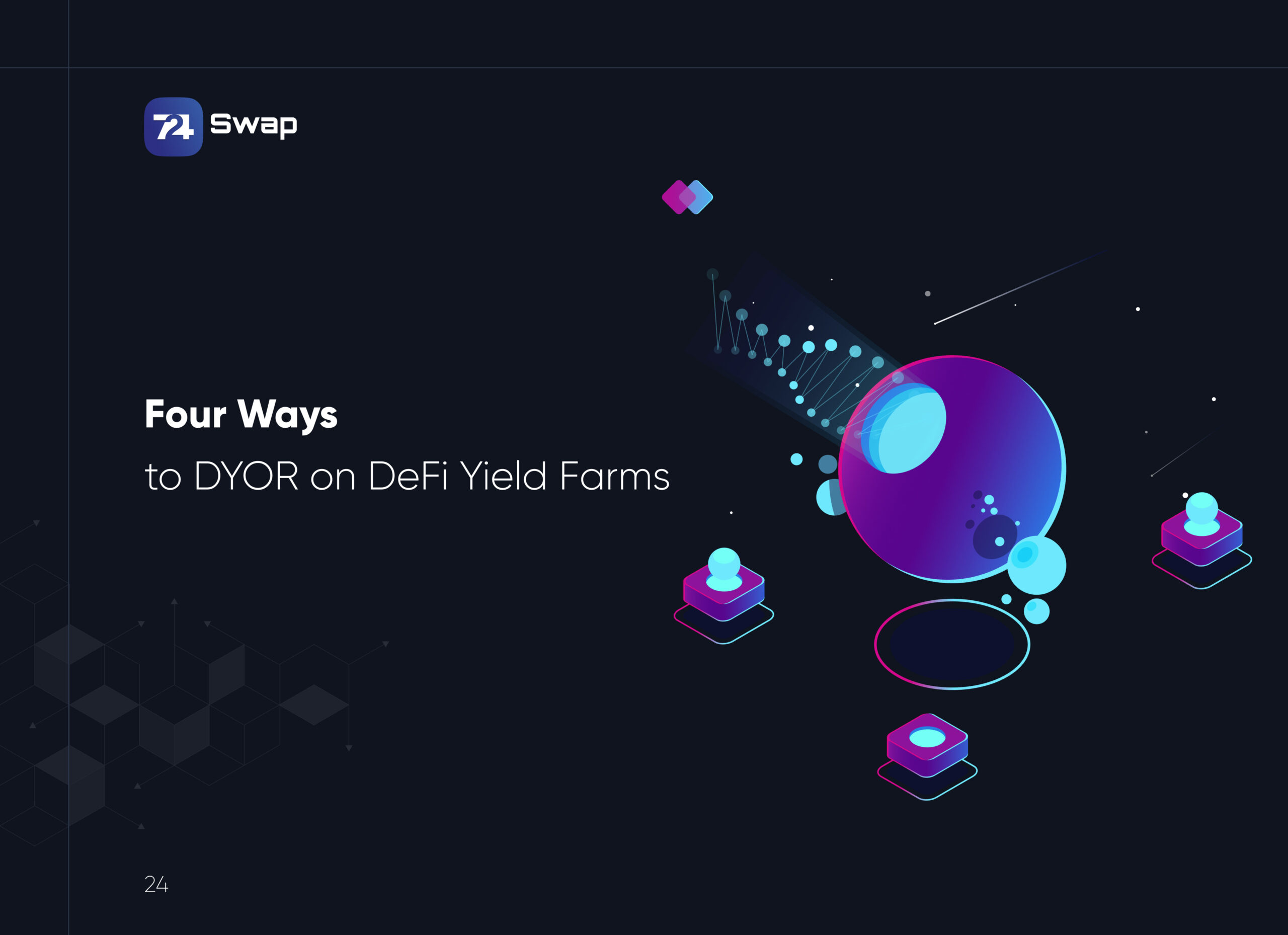Four Ways to DYOR on DeFi Yield Farms
Introduction
Decentralized Finance (DeFi) has revolutionized the financial landscape by providing innovative ways for individuals to earn returns on their cryptocurrency holdings. Yield farming, a key component of DeFi, involves providing liquidity to various protocols in exchange for rewards, often in the form of additional tokens. However, yield farming carries inherent risks, and conducting thorough research—commonly referred to as “Do Your Own Research” (DYOR)—is crucial for navigating this complex ecosystem. This article explores four comprehensive methods for conducting DYOR on DeFi yield farms, ensuring you make informed and secure investment decisions.
1. Evaluating the Protocol’s Fundamentals
A. Understanding the Team and Backers
- Team Background:
- Investigate the founding team’s experience and track record in the blockchain and financial sectors. Look for LinkedIn profiles, previous projects, and their professional reputation.
- Advisors and Investors:
- Assess the advisors and institutional backers. Well-known investors and reputable advisory boards often indicate a higher level of trust and potential for success.
B. Analyzing the Whitepaper
- Project Vision and Roadmap:
- A thorough reading of the whitepaper can provide insights into the project’s vision, goals, and technical roadmap. Ensure the project has a clear, achievable roadmap.
- Technical Details:
- Examine the technical details and the underlying mechanisms of the yield farming strategy. Understand how the protocol functions, how rewards are generated and distributed, and any innovative features.
C. Audits and Security Reviews
- Smart Contract Audits:
- Check for third-party security audits from reputable firms. Audits help identify vulnerabilities and assess the overall security of the protocol’s smart contracts.
- Bug Bounty Programs:
- Protocols that run bug bounty programs demonstrate a proactive approach to security, inviting ethical hackers to identify potential issues.
2. Assessing Financial Metrics and Yield Sustainability
A. Analyzing Yield and APY
- Historical Performance:
- Look at the historical Annual Percentage Yields (APYs) offered by the yield farm. High APYs can be attractive but often come with higher risks.
- Yield Source:
- Understand where the yields are coming from. Are they sustainable based on transaction fees, lending interest, or inflationary token emissions?
B. Liquidity and Total Value Locked (TVL)
- Liquidity Pools:
- Assess the liquidity in the pools. High liquidity generally indicates trust and stability, while low liquidity can lead to higher volatility and risk.
- TVL Metrics:
- Total Value Locked (TVL) is a critical metric. A higher TVL often signifies user confidence and robust platform health. Compare the TVL across similar platforms to gauge competitiveness.
C. Tokenomics
- Supply and Inflation:
- Evaluate the tokenomics, including the total supply, emission rate, and inflationary or deflationary mechanisms. Understanding how new tokens are minted and distributed is crucial.
- Utility and Use Cases:
- Investigate the token’s utility within the ecosystem. Tokens with multiple use cases (e.g., governance, staking, fee discounts) tend to have more stable and sustained demand.
3. Community Engagement and Sentiment Analysis
A. Social Media and Forums
- Official Channels:
- Join and monitor official social media channels such as Twitter, Telegram, Discord, and Reddit. Active and transparent communication from the team is a positive sign.
- Community Discussions:
- Engage in community discussions to gauge sentiment. Look for recurring issues, questions, and the overall tone of user interactions.
B. Independent Reviews and Influencers
- YouTube and Blogs:
- Watch or read independent reviews from credible influencers and bloggers. Be cautious of sponsored content and look for balanced, in-depth analyses.
- Third-Party Platforms:
- Platforms like DeFi Pulse, CoinGecko, and others provide valuable data and metrics on various DeFi projects. Use these resources to cross-check information.
C. Sentiment Analysis Tools
- Data Analytics:
- Utilize sentiment analysis tools that aggregate data from social media and forums to provide an overview of the community sentiment. These tools can help identify trends and potential red flags.
- User Feedback:
- Pay attention to user feedback and reviews on various platforms. High user satisfaction and positive experiences often correlate with a reliable and trustworthy project.
4. Risk Management and Diversification
A. Identifying Risks
- Smart Contract Risks:
- Understand the risks associated with smart contract bugs and exploits. Even audited contracts can have vulnerabilities.
- Market and Liquidity Risks:
- Evaluate the potential for impermanent loss in liquidity pools and market volatility. High rewards often come with high risks, including the possibility of significant financial loss.
B. Diversification Strategies
- Spreading Investments:
- Diversify your investments across multiple yield farms and DeFi projects. This reduces the impact of any single project’s failure on your overall portfolio.
- Risk-Reward Balance:
- Balance high-risk, high-reward investments with more stable, lower-yield options. This approach helps manage potential losses and achieve long-term growth.
C. Continuous Monitoring
- Regular Updates:
- Keep up with the latest news, updates, and changes in the protocols you’ve invested in. DeFi is a rapidly evolving space, and staying informed is crucial.
- Exit Strategies:
- Develop clear exit strategies for each investment. Know when to take profits, cut losses, and reallocate resources based on changing market conditions and project developments.
Conclusion
Decentralized Finance (DeFi) yield farming offers lucrative opportunities but comes with significant risks. Conducting thorough and ongoing research (DYOR) is essential for making informed investment decisions. By evaluating the fundamentals of the protocol, assessing financial metrics, engaging with the community, and implementing robust risk management strategies, you can navigate the complex DeFi landscape more effectively. As the DeFi ecosystem continues to evolve, staying informed and vigilant will be key to maximizing returns and minimizing risks in yield farming endeavors.
